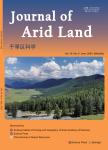Assessment of ecological quality in Northwest China(2000-2020)using the Google Earth Engine platform:Climate factors and land use/land cover contribute to ecological quality
Assessment of ecological quality in Northwest China(2000–2020) using the Google Earth Engine platform: Climate factors and land use/land cover contribute to ecological quality作者机构:College of Geography and Remote Sensing ScienceXinjiang UniversityUrumqi 800046China Xinjiang Key Laboratory of Oasis EcologyXinjiang UniversityUrumqi 830046China Key Laboratory of Smart City and Environment Modelling of Higher Education InstituteXinjiang UniversityUrumqi 830046China
出 版 物:《Journal of Arid Land》 (干旱区科学(英文版))
年 卷 期:2022年第14卷第11期
页 面:1196-1211页
核心收录:
学科分类:0830[工学-环境科学与工程(可授工学、理学、农学学位)] 08[工学] 083305[工学-城乡生态环境与基础设施规划] 0804[工学-仪器科学与技术] 0833[工学-城乡规划学]
基 金:the Key Laboratory Open Subjects of Xinjiang Uygur Autonomous Region Science and Technology Department(2020D04038) the Key Project of Natural Science Foundation of Xinjiang Uygur Autonomous Region(2021D01D06) the National Natural Science Foundation of China(41961059).
主 题:ecological quality land use/land cover spatiotemporal change remote sensing ecological index(RSEI) Google Earth Engine Xinjiang
摘 要:The ecological quality of inland areas is an important aspect of the United Nations Sustainable Development Goals(UN SDGs).The ecological environment of Northwest China is vulnerable to changes in climate and land use/land cover,and the changes in ecological quality in this arid region over the last two decades are not well understood.This makes it more difficult to advance the UN SDGs and develop appropriate measures at the regional level.In this study,we used the Moderate Resolution Imaging Spectroradiometer(MODIS)products to generate remote sensing ecological index(RSEI)on the Google Earth Engine(GEE)platform to examine the relationship between ecological quality and environment in Xinjiang during the last two decades(from 2000 to 2020).We analyzed a 21-year time series of the trends and spatial characteristics of ecological quality.We further assessed the importance of different environmental factors affecting ecological quality through the random forest algorithm using data from statistical yearbooks and land use products.Our results show that the RSEI constructed using the GEE platform can accurately reflect the ecological quality information in Xinjiang because the contribution of the first principal component was higher than 90.00%.The ecological quality in Xinjiang has increased significantly over the last two decades,with the northern part of this region having a better ecological quality than the southern part.The areas with slightly improved ecological quality accounted for 31.26%of the total land area of Xinjiang,whereas only 3.55%of the land area was classified as having a slightly worsen(3.16%)or worsen(0.39%)ecological quality.The vast majority of the deterioration in ecological quality mainly occurred in the barren areas Temperature,precipitation,closed shrublands,grasslands and savannas were the top five environmental factors affecting the changes in RSEI.Environmental factors were allocated different weights for different RSEI categories.In general,the recovery of ecological quality in Xinjiang has been controlled by climate and land use/land cover during the last two decades and policy-driven ecological restoration is therefore crucial.Rapid monitoring of inland ecological quality using the GEE platform is projected to aid in the advancement of the comprehensive assessment of the UN SDGs.



